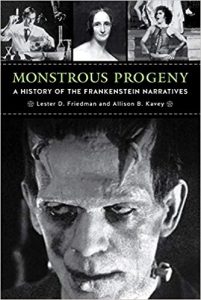| Lester D. Friedman and Allison B. Kavey Monstrous Progeny: A History of the Frankenstein Narratives. New Brunswick, New Jersey, and London: Rutgers University Press, 2016. ISBN 978-0813564234 US$27.95 (pb) 237pp (Review copy supplied by Rutgers University Press) |
 |
The bicentenary of the publication of Mary Shelley’s Frankenstein in 2018 witnessed an explosion of interest in this masterpiece of nineteenth-century gothic fiction. Academic and popular conferences proliferated across the world – from Canberra to Hoboken. Mary Shelley, a film tracing Shelley’s early life and her relationship with her eventual husband Percy Shelley, was released (to a mixed response). Numerous academic books and articles on the topic were published, and Frankenreads, a project instantiated by the Keats-Shelley Association of America, sponsored events celebrating the novel including a public, world-wide readathon of Frankenstein on Halloween 2018. Monstrous Progeny: A History of the Frankenstein Narratives by historian Alison B. Kavey and film scholar Lester D. Friedman, was released in the build-up to this bicentenary and it explores some of the scientific and philosophical trends that animated Shelley’s novel, before moving on to examine “the subsequent works – primarily the films – that drew their inspiration from” Frankenstein.
Before I go on to describe some the book’s contents, I would like to point out that the title of Friedman and Kavey’s book is based on a rather distracting mis-quotation from Shelley’s introduction to her revised 1831 edition of the novel. Towards the end of her introduction, Shelley bids, “my hideous progeny to go forth and prosper. I have an affection for it, for it was the offspring of happy days, when death and grief were but words, which found no true echo in my heart.” Friedman and Kavey do not explore the meaning behind their title in any great detail, but Shelley’s original quotation provides a perfect preface to any study looking at the long afterlife of the novel and its monster. As early as 1831, we see Shelley recognising that she, as author (and quasi-mother), now has little control over the monster she had created which, as Friedman and Kaveney point out in Chapter Three, already had a cultural life well beyond its original publication. In fact, Friedman and Kavey remind us that the very first stage adaptations of Shelley’s novel, Presumption; or, The Fate of Frankenstein appeared in 1823, some five years after Frankenstein’s original publication, and these adaptations substantially altered “Shelley’s original vision in the popular imagination” (p.81). It’s not entirely clear why the two authors would misquote Shelley in their title.
Throughout the book the choice has been made to quote more extensively from Shelley’s novel than from other sources. While this approach certainly highlights the complexities of Shelley’s novel, and the text’s openness to interpretation on numerous fronts, it flattens the overall effect of the book’s argument. Moreover, while students and newcomers to Shelley’s novel and its monstrous children will appreciate the broad coverage of this book (it begins with Shelley’s novel and finishes with the TV series Penny Dreadful (2014-16), it suffers a little as a result of its attempt to cater for this broad audience. For example, Chapter One, which explores the intellectual history of Shelley’s novel makes a number of assertions about scientific endeavour in the eighteenth and nineteenth centuries that might have benefitted from a closer engagement with actual scientific texts from this period. If, for example, Walton’s reliability as a narrator and explorer “depends upon his status as a gentleman,” (p.27) which contemporary texts support this view? Similarly, Chapter Two, which deals with Frankenstein’s medical history, pays close attention to questions to do with the embodiment of the monster and considers (among other things) the idea that the monster might be a demonic entity. But in order to fully explicate this theory, more recourse to actual pre-eighteenth century texts exploring demons and the demonic would have been useful.
I found Chapter Three, which deals with the novel’s adaptation from page to stage, to be the most interesting in the book. It is important to recognise the long history of adaptations of Shelley’s novel, and to highlight the key role they played in forming subsequent aspects of Frankensteinian mythology. Indeed, Friedman and Kavey remind us that as early as the 1823 adaptation, Shelley’s articulate and intelligent monster had turned into a mute of dubious mental capacity. As Chapter Four argues, these aspects of the monster carry on into the films of Thomas Edison and James Whale (most significantly, his iconic 1931 film, Frankenstein) and are articulated in various ways in the extensive Universal and Hammer cycle of Frankenstein films.
Chapter Five focuses on a number of “Frankenstein films” which, the authors argue, fall into three broad categories: 1) Transitions, featuring creatures who were never alive being given life (Young Frankenstein [1974] and Frankenweenie [2012]); 2) Translations, which explore hybrid creations brought back to life, but that do not specifically use Shelley’s characters or settings (Jurassic Park [1993]); and 3) Transmutations, featuring artificially created creatures such as robots and cyborgs (Robocop [1987]). This chapter offers useful summaries of numerous twentieth and twenty-first century texts that draw on the Frankenstein narrative, and would be a good place to begin any exploration of these more recent Frankenstein-inspired films and television series.
Monstrous Progeny is an enjoyable and accessible addition to the extensive criticism already available on Mary Shelley’s novel and its cultural afterlives. Anyone who is interested in tracing the text’s movement through the nineteenth, twentieth and twenty-first centuries will appreciate Freidman and Kavey’s approach.
Claire Knowles,
La Trobe University, Australia
